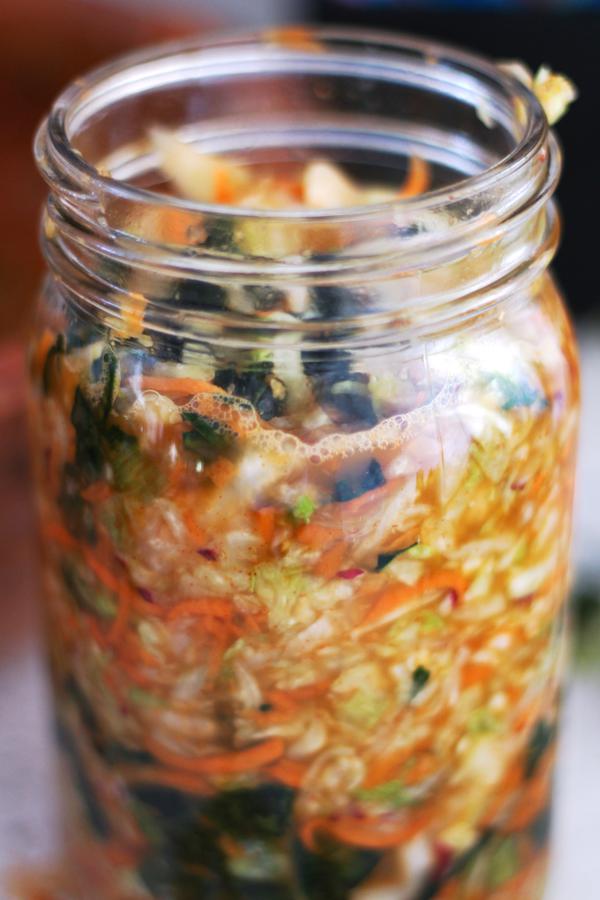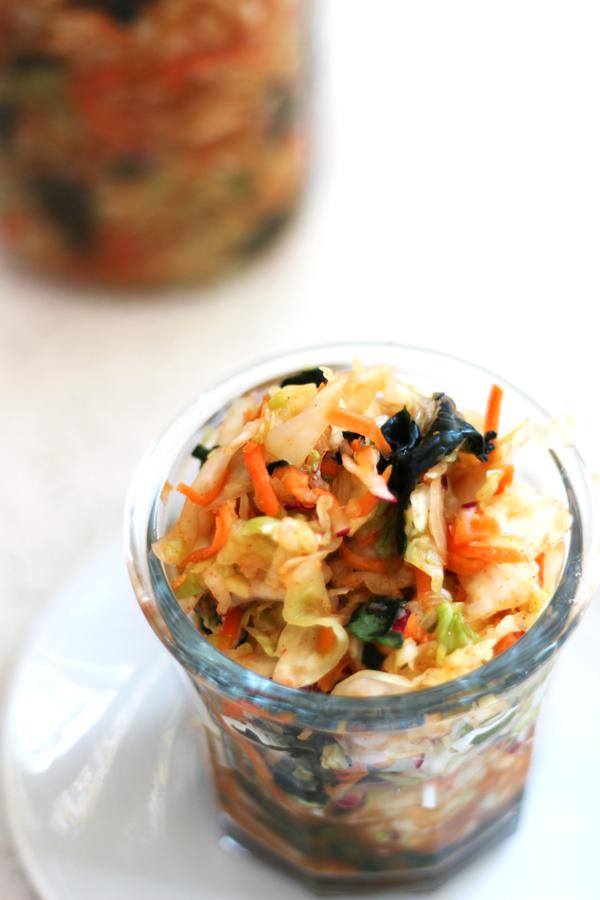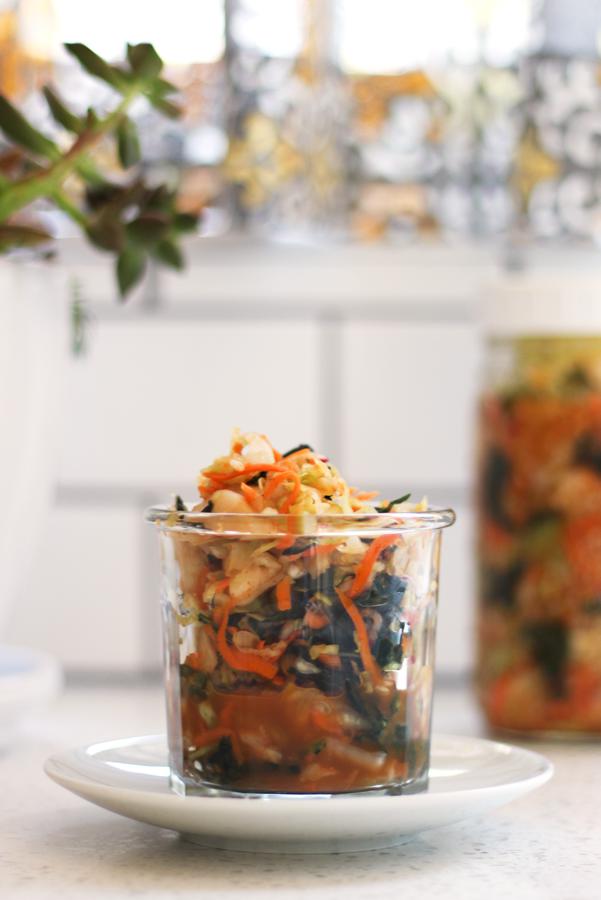Garlicky, spicy, savory and bursting with unami flavor. Kale Kimchi is my version of Kimchi with the added bonus of nutrient rich kale.
I had a party a few months back and introduced this recipe to my guests. The BBQ was smoking, our teal green picnic table was packed with salads, yummy sides and nestled among all of that was my Kale Kimchi. Just hanging out waiting to be scooped out and plopped on a plate. To my surprise the 1/2 gallon jar was mostly gone by the end of the night.
A few weeks later I brought a large mason jar of Kale Kimchi to a party where they made pork sliders. It was a hit! It was all gone, crowd tested and approved.
Health benefits of eating fermented foods like kimchi
Some of the positive effects I have experienced eating fermented foods are clearer skin, better digestion and increased energy.
- Eating fermented foods daily will strengthen your immune system, reduce bloating and control weight.
- Can heal a multitude of health issues including leaky gut, IBS, weight loss, lead to clearer skin and better immune system.
- 1 head of cabbage
- 2 tablespoons fine celtic sea salt
- 1 bunch of kale hand torn into bite sized pieces.
- 4 carrots, grated
- 8 radishes, grated
- 2 green onions, chopped
- 4 cloves of garlic pressed or minced
- 1 heaping tablespoon of grated ginger
- 1 tablespoon of paprika
- 1 teaspoon of cayenne pepper (add more if you want it spicier)
- 2 quart sized mason jars or 1 half gallon mason jar.
- Pull 3 outer leaves off the head of cabbage and set aside. Shred the remaining cabbage in a food processor, mandolin or chop with a knife. Add it to a big bowl.
- Sprinkle the cabbage with sea salt. Mix and massage the sea salt into the cabbage for about 5 minutes.
- Set the cabbage aside and let it sit for 15-20 minutes so the sea salt has time to draw out the liquid and make the cabbage soft.
- Hand tear the kale into bite sized pieces and add to the cabbage mixture.
- Grate the radishes and carrots using a cheese grater or food processor and add to the cabbage mixture.
- Add the chopped green onions, garlic, ginger, paprika and cayenne pepper to the cabbage mixture.
- Mix and squeeze the cabbage mixture with your hands or a vegetable pounder. If liquid comes out when squeezed then it is ready for the next step.
- Pack the cabbage in the mason jar tightly with either your hand or a vegetable pounder. Push it all the way down until it submerges in its own juices (this is the brine).
- Repeat this until there is about 1½ inches of space from the top of the jar.
- Roll up the leaves and place them in the jar to push the cabbage under the brine.
- Screw on the jar loosely so gas can escape as fermentation takes place. Set on the counter for 5-7 days in a cool, shaded place. Place a plate under the mason jar in case it bubbles over and makes a mess.
- During fermentation the sauerkraut will bubble a little and become cloudy. If scum appears, remove it with a spoon.
- Remove the rolled up cabbage leaves and toss in the garbage before eating.
- Store in the fridge.
Kale Kimchi is a must for your next fermentation adventure. Do you like kimchi? When was the first time you tried it? Let me know in the comments below and if you think any of your friends or family would like this recipe please share it with them by clicking on the social media icons in this post.
[optinlock id=”4″][/optinlock]
Some links on this page are affiliate links and they are all for companies that I support and buy from myself. If you decide to purchase any of these products through these links, I will earn a small commission and you will have my sincere thanks for supporting Fermented Food Lab.



Sounds fabulous! Always looking for more ways to get kale in. What radishes do you use in yours? Thanks, Danielle! Love your work! Thia
Thank you Cynthia! I used regular red radishes. You could use any kind you want.
Hi Danielle, I made the kale kimchi last Thursday. I had to use kosher salt, and a one gallon jar. After I packed the vegetables in the jar, I used a bowl to hold everything down, put the cover on, and put a towel over it to keep it shaded. I really never saw any fermentation taking place and am wondering how I would know if it worked. Do you have photos of what it should look like or any advice for me on if I did it correctly?
Hi Pam,
Some simple guidelines that it’s fermenting are:
1. The sauerkraut will become duller in color.
2. The brine will become cloudy
3. Small air pockets will form and when you open a lid (if it was closed tight in the first place) gas will escape making a hiss sound.
4. It will take on a sour flavor.
Fermentation takes longer in the winter because the cold slows down the process. It probably just needs more time.
Dannielle, Your Blog has got me educated and totally excited about fermenting food and adding them to my daily life. Maybe about 1 year age I stumbled across your blog while surfing the web. I first made your pickled asparagus. It was amazing! I haven’t made anything since then But just recently I have been wanting to make fermented foods so I always have some kind in my fridge to add daily to my diet, for the many reasons you have taught me about the heath benefits. I saw that you were going to have the 21 day challenge, I signed up right away. A few weeks ago I made your kimchi recipe. And OMG! My most favorite…So delicious! I cant seem to get enough of it, and I just made another batch today. Cant hardly wait for 5 to 7 Days for it to be done fermenting. Mean while I’m rationing my earlier batch so i don’t run out of it before my new batch is done becuse I love to eat it everyday!
Last Friday I made the Blueberry Shrub. I’m not sure if it turned out the way it was supposed to though..for some reason it jelled up like a jelly… with some liquid on the bottom???
Thank you Krystin, I’m so happy to hear that you’re enjoying my recipes :)
For the shrub, when it’s ready, shake it up and then strain the fruit out. That happened to me too.
Ok great, I will strain it.
Thank you :)
Homemade is so much better and MSG free ! http://earthlychow.com/tired-kimchi-msg-make
Danielle,
love the recpie, this time when I made it I have noticed that about half the jar is sans liquid (2 weeks later), is that a problem?
Sometimes the cabbage re-absorbs the brine. Pound the cabbage down with your hand, or spoon and the brine will come out again. If not, you can add brine brine to it, so it stays fresh. Basic Brine is 2 tablespoons of salt + 4 cups of water.
Love this recipe! It is now my go-to kimchi recipe and I make it all the time. Thanks so much for sharing it!